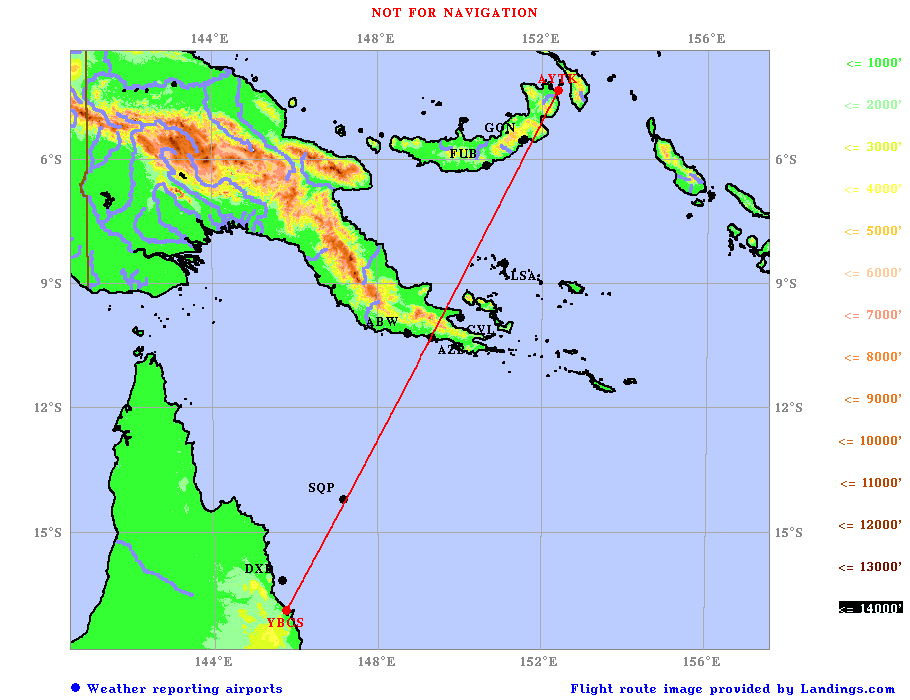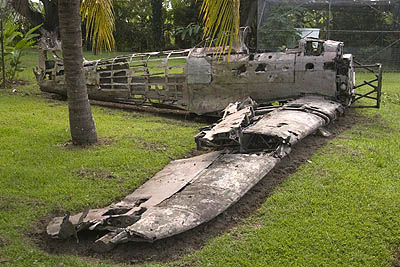

When I had first planned my route, I had found the Lakunai airport which had been the main Japanese airport on the island of Rabaul. That name, Rabaul, reverberated with the sound of the war - Japanese Zeros mixing it up with American Hellcats, Corsairs and Lightnings, destroyers running ‘the slot’ down to Guadalcanal, night battles as the ‘Cans’ slugged it out, banzai charges in the dank jungles, desperate times and heroic victories. The war in the Pacific turned during these battles and Rabaul was the main Japanese base.
There had been over one hundred thousand Japanese soldiers at Rabaul. You might be wondering why you never heard of the landings at Rabaul or the Battle for Rabaul. Early in their planning, the Japanese High Command knew they would never be able to take and fortify the entire Pacific region. So they came up with a compromise, the so-called ribbon defense. They would have many small bases on the perimeter of their conquests and a few highly defended fortresses. These would be so expensive in terms of casualties to conquer that the Americans would never be able to take them. Rabaul was to be one of their fortresses that the Americans could never take. They were right, the Americans never did.
The American commanders saw the same picture when they began to plan the battle against the Japanese. But they had a different vision, one that turned out brilliantly. Take only the islands they needed and leave behind the fortresses, isolated, cut off from support, and therefore, useless, to whither and die on the vine. That is what the Americans did with Rabaul. They took islands surrounding Rabaul, the first being Guadalcanal. During the fighting they eventually shot down all of the Japanese aircraft at Rabaul. Then they leap-frogged past Rabaul, leaving the defenders with nothing to defend against. Cut off, the garrison shriveled into impotence. But the fighting in the Solomon Islands was some of the heaviest of the Pacific campaign. It was during this fighting that the Americans pilots, at great cost, learned how to beat the Japanese aircraft. And one of the main reasons the American eventually won was the Corsair.
So Rabaul was put on my route. Unfortunately, the town of Rabaul had been built right on the caldera of an active volcano, not exactly good planning. The town and the airport had been covered in ash when the local volcano had erupted in 1994. Lakunai still had several wrecks of Japanese planes left over from the vicious fighting that took place there, but they were now covered in ash. The locals had rebuilt a new airport at Tokua. I was a bit disappointed that the old airport was unusable. I wondered what it would have felt like, to fly my Corsair into that base. Would the ghosts of Zeros follow me down on final, still fighting on after all these years?
As I approached Rabaul I could see the chain of islands stretching away to the right where so much fighting had taken place. Who knows how many planes sit under those quiet waters? The channel between these islands was called Ironbottom Sound because of all the metal sitting on the bottom, sunken ships and aircraft. It was here that the American soldiers and sailors had turned back the Japanese and slowly began returning the world to peace and freedom. I admit, I felt a chill as I looked out over those seas where so many brave men had fought.
I landed at the airport, all bright and new. After having the plane serviced, I hired a cabbie who spoke a little English. I let him know I wanted to see the Japanese equipment left over. I think he had a route already in use because we set off straight to the old airport. We got out and he showed me a few wrecks, mostly covered by ash. The ghosts were everywhere. Some were kept almost like souvenirs, all neat and tidy. Others were just abandoned trash.
 We hopped back into the cab and he took me out to the hills where the Japanese had tunneled into the rocks. There were tunnels all over the place, many still filled with old discarded equipment. I even found part of a Zero, the wings stripped off, in one of the tunnels. I wondered what they had thought when they brought the plane into a tunnel. Were they planning to use it as a kamikaze when the Americans finally tried to land?
We hopped back into the cab and he took me out to the hills where the Japanese had tunneled into the rocks. There were tunnels all over the place, many still filled with old discarded equipment. I even found part of a Zero, the wings stripped off, in one of the tunnels. I wondered what they had thought when they brought the plane into a tunnel. Were they planning to use it as a kamikaze when the Americans finally tried to land?
It was a fascinating day wandering into the tunnels. The cabbie was more than happy to show me around. I gave him a big tip when he dropped me off at the hotel next to the airport. I had a long flight the next day so after an early dinner I went to my room and fell asleep watching reruns of old American sitcoms.
Return to Around the World homepage
Copyright Rod O'Steele © 2008